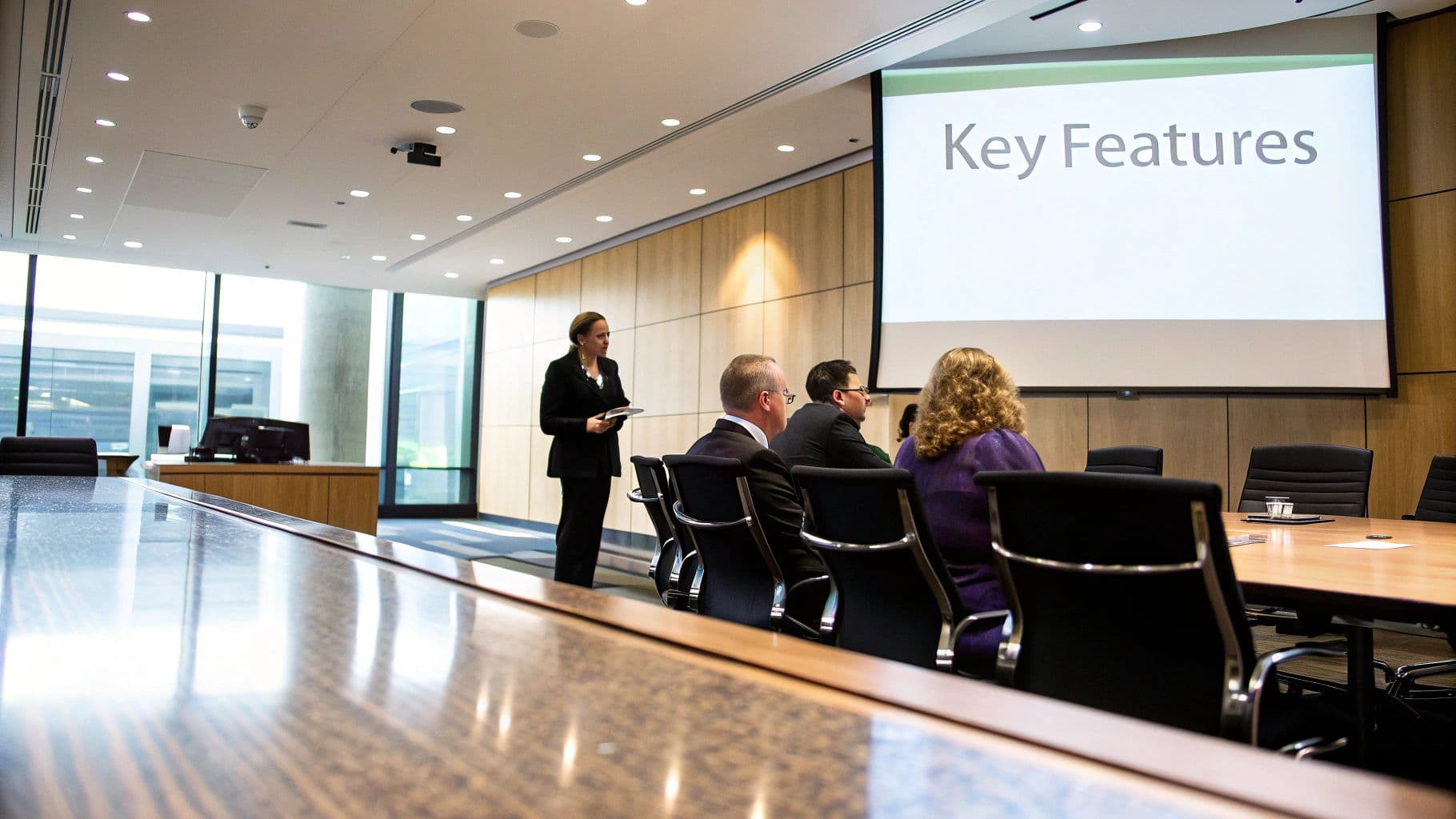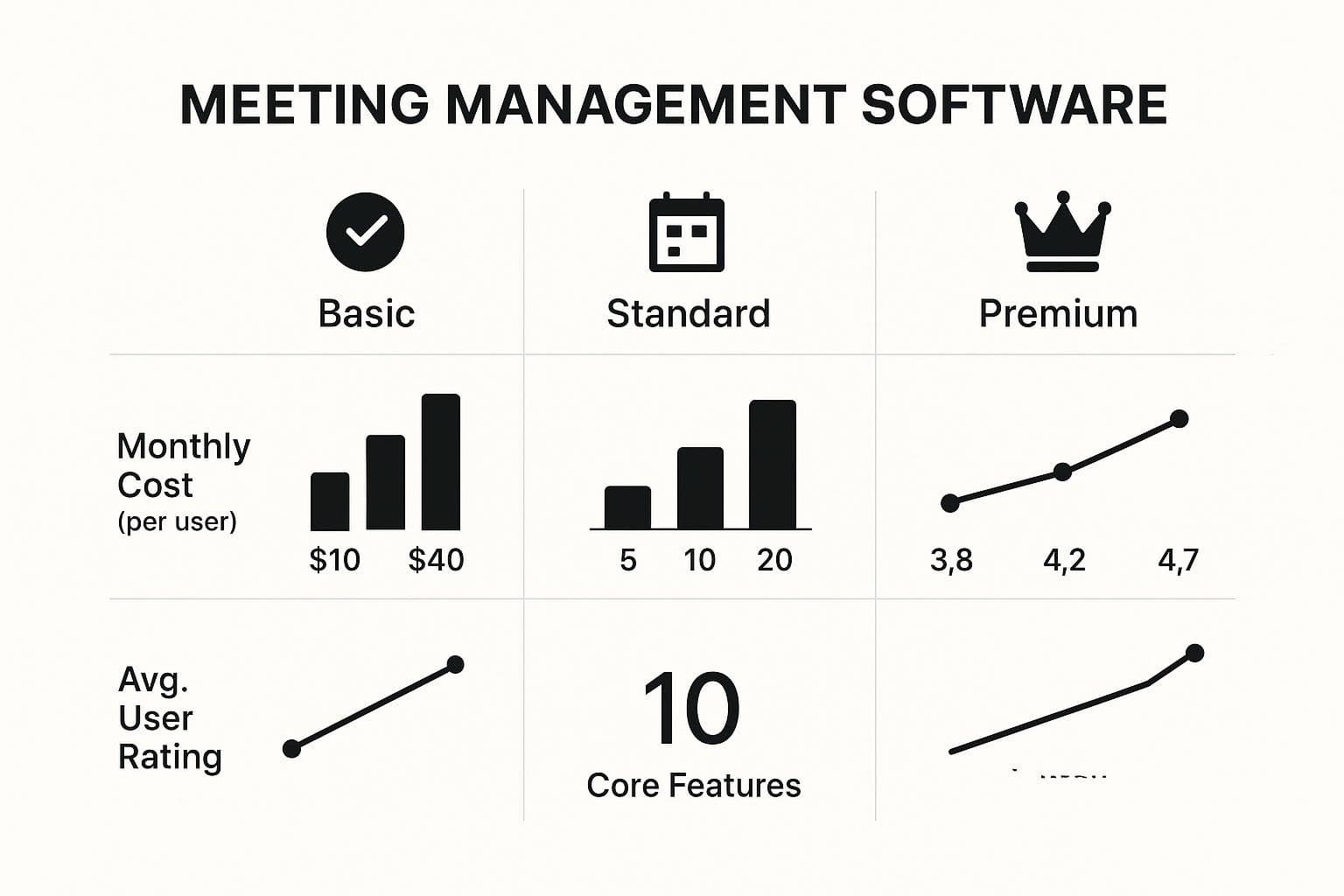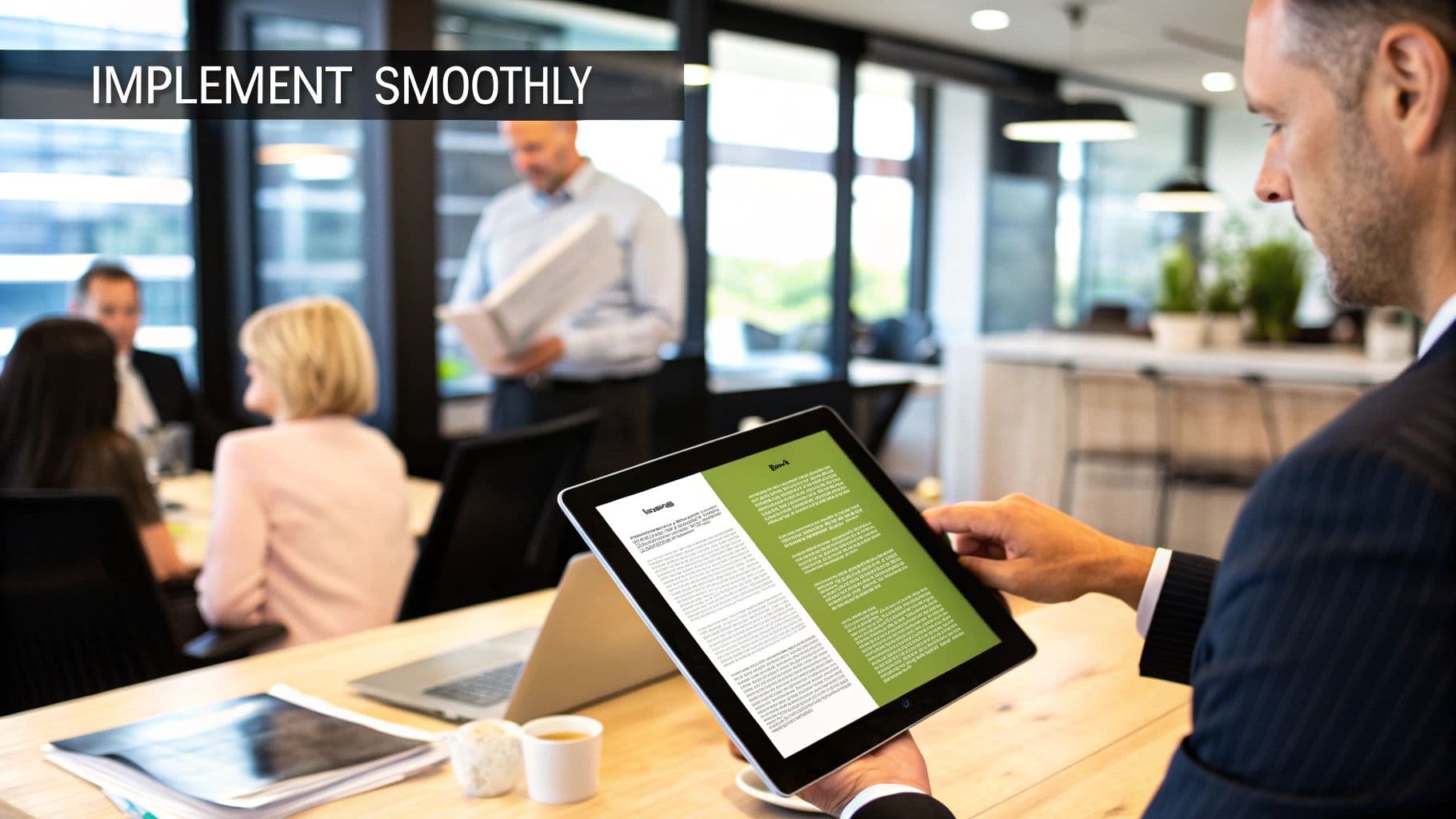Let's be honest, most meetings are a necessary evil. They're often disorganized, lack clear goals, and rarely result in tangible action. But what if you could change that? The right meeting management software can turn those chaotic sessions into focused, productive work by creating a single, reliable hub for everything related to your meetings. This is especially critical now that so many of us are working in hybrid or remote setups.
Why Better Meetings Start with the Right Software
Modern business revolves around meetings, yet so many teams still fumble the basics. We’ve all been there: agendas are scattered across emails, follow-ups are forgotten, and no one is quite sure who's responsible for what. When you don't have a central system, crucial decisions and discussions get buried in overflowing inboxes or lost in a dozen different documents. It's a recipe for wasted time and stalled projects.
This is exactly the problem that dedicated meeting management software is built to solve. These tools provide a much-needed structure for the entire meeting lifecycle, from planning to follow-up.
From Chaos to Cohesion
Instead of trying to piece together a workflow with separate apps for scheduling, note-taking, and task tracking, these platforms bring it all under one roof. They make sure every meeting has a clear purpose right from the get-go.
- Centralized Agendas: Everyone shows up on the same page, fully prepared for the discussion.
- Actionable Notes: Conversations are translated directly into assigned tasks, which builds instant accountability. If you want to get really good at this, check out our guide on how to take better meeting notes.
- Seamless Follow-ups: Automated summaries and reminders mean no action item ever falls through the cracks.
Moving from manual coordination to an automated workflow pays off quickly. Teams spend less time on admin, feel less frustrated by meetings, and actually see conversations drive business goals forward. The market data backs this up.
This boom is largely fueled by the shift to hybrid and remote work, which demands better digital tools for keeping everyone organized. You can dig deeper into this market growth on verifiedmarketreports.com. By choosing the right platform, you can build a culture of accountability where meetings stop being a time-sink and start being a powerful engine for productivity.
What to Look For in Meeting Management Software
Before we pit the top platforms against each other, let's talk about what actually makes a great meeting tool. It's easy to get lost in a sea of feature checklists, but what really matters is finding software that turns messy conversations into clear, actionable results.
These aren't just fancy calendars. The best tools are designed to manage the entire meeting lifecycle—from planning the agenda and taking notes to assigning tasks and tracking decisions. Think of them as a central hub for corporate logistics.
And it's clear businesses are catching on. The market for this software hit USD 4.72 billion in 2024 and is expected to rocket to USD 10.12 billion by 2032. That's a huge jump, and it shows a real demand for tools that handle the tedious prep and follow-up work, so teams can focus on what matters. You can dig into the full market projections to see the growing demand for these platforms on verifiedmarketresearch.com.
Collaborative Agenda Builders
A good meeting starts with a solid agenda. Modern tools have turned the old static document into a living, collaborative workspace. No more emailing Word docs back and forth. Now, your team can add topics, drop in relevant files, and give context right on a shared agenda before anyone even joins the call.
This simple shift means everyone shows up on the same page. For instance, a project manager might add "Budget Review," and the finance lead can attach the latest spreadsheet directly to that item. No more last-minute scrambling for documents. It makes preparation a shared, seamless effort instead of a solo chore.
AI-Powered Minute-Taking and Summaries
Let's be honest: nobody likes taking minutes. It’s tedious, and you’re bound to miss something important. This is where AI has become a total game-changer. The top meeting platforms can now transcribe conversations in real-time, figure out who’s talking, and spit out a clean, accurate summary of the whole discussion.
This frees everyone up to actually participate in the meeting instead of having their head buried in a notepad. Once it's over, the AI-generated summary gives you the highlights—key decisions, action items, and takeaways. It’s like having a super-efficient assistant in every single meeting.
This is a lifesaver for hybrid teams. If someone couldn't make it, they can get the essential outcomes in a few minutes without having to watch the entire recording. It's all about making information accessible and ready to act on.
Integrated Action Item Tracking
One of the biggest reasons meetings fail is that action items fall into a black hole. Great ideas are thrown around, tasks are assigned, and then… nothing. Good meeting software closes that loop by building task tracking right into the workflow.
During the meeting, anyone can create an action item, assign it to someone, and pop in a due date without ever leaving the notes. Even better, these tasks often sync automatically with project management tools like Asana, Trello, or Jira.
Here’s a great example of how a platform like Fellow makes this crystal clear.

You can see how the talking points on the left are tied directly to assigned action items on the right. There's no ambiguity, just immediate accountability.
Centralized Decision Logs
Finally, making a decision is only half the job. You have to remember it, and so does everyone else. A decision log is a dedicated space to create a permanent, searchable record of every important choice your team makes.
This feature solves a few classic problems:
- Stops you from re-hashing old debates. Anyone can look up why a decision was made.
- Gets new hires up to speed. They can review past decisions to understand a project's history.
- Keeps everyone aligned. It becomes the single source of truth for your team's direction.
By capturing not just what was decided but also the why, a decision log helps build institutional knowledge and keeps the team moving forward with confidence.
A Practical Comparison of Leading Platforms
Once you know what you’re looking for in a great meeting tool, it's time to put the top contenders head-to-head. Picking the right meeting management software isn't about finding the one with the most bells and whistles. It's about finding the tool that clicks with your team's workflow, culture, and the apps you already use every day.
We're going to compare three heavyweights—Fellow, Hugo, and Beenote—on the things that actually matter for getting work done. This isn't just a feature checklist; it's a look at the real-world differences in how they handle agendas, tasks, AI, and integrations. The idea is to help you picture which one would feel like a natural fit and which might just get in the way.
This chart gives a quick snapshot of how different software tiers generally stack up on cost, features, and what users think, which sets the stage for our deeper dive.

As you can see, the priciest plans pack in the most features, but the standard tiers often hit that sweet spot of value and functionality, which is why they tend to get high marks from users.
Fellow: The All-in-One Collaboration Hub
Fellow doesn’t just want to manage your meetings; it wants to be the central hub for your team’s productivity. It’s built for teams that want to weave good meeting habits into their daily rhythm, whether it's for a one-on-one or a big project kickoff. The interface is clean and built around a simple idea: meetings should connect directly to team goals and performance.
What Fellow does exceptionally well is make agenda building a continuous, collaborative effort. Agendas aren't just one-off documents. They can be part of a series, letting you carry over talking points from one week to the next—perfect for managers who need to maintain a running thread in their regular check-ins.
One of its killer features is how seamlessly it integrates feedback and recognition right into the meeting.
- Actionable Agendas: Team members can easily add discussion points, attach relevant files, and assign tasks before the meeting, so everyone shows up ready to contribute.
- Integrated Feedback: The platform has built-in tools for giving and requesting feedback in real time, connecting performance conversations to actual meeting results.
- Goal Tracking: Fellow lets you link meeting discussions and action items directly to your company’s bigger objectives (like OKRs), making sure every conversation pushes you forward.
Hugo: The Calendar-Centric Note Taker
Hugo comes at the problem from a completely different angle, building its entire experience around your calendar. It works like a smart overlay for your Google or Outlook Calendar, automatically organizing all your notes, agendas, and tasks by the meeting they belong to. If you live and breathe by your calendar, Hugo feels like an instant upgrade to your existing workflow.
The whole philosophy behind Hugo is making meeting knowledge easy to find and use. Instead of notes getting lost in random documents, Hugo creates a single, searchable database of every conversation. This is a game-changer for cross-functional teams where insights from a sales call are suddenly needed in a product meeting.
Hugo’s true strength, though, is its massive library of integrations. It connects with over 20 different project management and communication tools—think Slack, Asana, Trello, and Jira. This means you can send tasks and decisions from a meeting straight into the apps where the work actually gets done.
Beenote: The Formal Meeting Specialist
Beenote is purpose-built for organizations that need serious structure and governance. It's the go-to tool for sectors like government, non-profits, and large corporations where board meetings and official committees require strict record-keeping and procedural rules (like Robert's Rules of Order).
While Fellow and Hugo are designed for nimble, everyday collaboration, Beenote manages the entire lifecycle of a formal meeting. It gives you powerful tools for sending official meeting notices, managing approvals, tracking attendance, and generating legally sound minutes. For a corporate secretary or municipal clerk, it's an absolute necessity.
Here’s where Beenote really stands out:
- Structured Minute-Taking: The platform walks you through a formal process to ensure every decision, motion, and vote is recorded accurately.
- Approval Workflows: You can circulate draft minutes for review and approval with automated workflows, which creates a clean and clear audit trail.
- Secure Document Portal: It acts as a secure, central home for all meeting documents, from agendas to signed minutes.
Feature and Integration Showdown
When you get down to it, the small differences in features and integrations can make a huge difference in your team’s day-to-day. All three platforms nail the basics of agendas and notes, but they take very different approaches to AI and how they connect with other tools.
A key battleground is how each platform uses AI to generate summaries. Fellow’s AI is woven into its goal-tracking system, often suggesting action items that tie back to team objectives. Hugo’s AI, on the other hand, is all about plucking out key decisions and tasks that you can quickly zap over to another app. Beenote uses its AI for precision, focusing on accurate transcription to help draft formal minutes.
Integrations tell a similar story. Hugo is the undisputed champion for teams juggling a ton of different apps. Fellow offers a more curated list, focusing on deep connections with HR and project management systems. Beenote’s integrations are more specialized, designed to hook into governance and document management platforms.
Comparing Key Features of Meeting Software Platforms
Here’s a detailed breakdown of how leading meeting management software platforms compare across essential features, integrations, and ideal user profiles.
| Platform | Core Agenda Features | AI Capabilities (Transcription/Summaries) | Key Integrations | Ideal For |
|---|---|---|---|---|
| Fellow | Collaborative, recurring agendas with integrated goal tracking and feedback. | AI suggests action items linked to OKRs and provides detailed meeting summaries. | Deep integrations with Slack, Jira, Asana, and HRIS platforms. | Managers and teams focused on performance, accountability, and structured one-on-ones. |
| Hugo | Calendar-centric agendas and notes automatically organized by event. | Focuses on shareable summaries and smart task detection for easy export. | Extensive library of 20+ integrations including Salesforce, Trello, and Zapier. | Cross-functional teams needing a flexible, highly-connected note-taking system. |
| Beenote | Formal agenda creation with tools for motions, voting, and attendance tracking. | High-accuracy transcription and AI-assisted drafting of official meeting minutes. | Integrates with Microsoft 365 and specialized document management systems. | Government bodies, boards, and organizations requiring formal meeting governance. |
In the end, the right choice really boils down to your team’s DNA. A fast-moving startup will probably love Hugo’s flexibility. A larger company trying to standardize its management practices will find a great partner in Fellow. And a city council simply couldn't do its job without the formal structure of Beenote. Look past the marketing hype and focus on these practical differences to find the platform that will truly elevate your meeting culture.
Understanding Pricing Models and Real Costs
The sticker price you see on a meeting tool's website is rarely the full story. To get a real sense of the cost, you have to look past the monthly fee and consider the total investment. Think about the time it takes to get everyone up and running, the training involved, and any extra add-ons you might need down the road.
Choosing the right plan is a bit of a balancing act. You don't want to shell out for a premium plan full of features you'll never use. At the same time, picking a free plan that your team outgrows in six months just creates another headache. The sweet spot is a tool that solves today’s problems and can grow with you.

Breaking Down Common Pricing Tiers
Most meeting software companies use a few standard pricing models, each aimed at different types of teams. Getting familiar with them is the first step toward making a smart choice. If you want to dive deeper, our guide on understanding meeting tool pricing structures has even more detail.
- Free Forever Plans: These are great for individuals or tiny teams just dipping their toes in the water. You'll get the essentials—like basic agenda templates and note-taking—but expect limits on users, meetings, or the number of apps you can connect.
- Per-User, Per-Month Subscriptions: This is the go-to model for most growing businesses. You pay a flat fee for each person, and different pricing tiers unlock more powerful tools like AI-powered summaries, beefier integrations, and detailed analytics.
- Enterprise and Custom Plans: Built for large organizations with complex needs. These plans usually come with all the bells and whistles: advanced security protocols, single sign-on (SSO), and a dedicated support contact. Pricing is almost always custom-quoted.
The trick is to match your team’s actual workflow to the features in each tier. A sales team, for example, will probably get the most value from a plan with tight CRM integration, while a product team will want something with great task management.
On-Premise vs. Cloud Deployment
Another major factor that impacts cost is where the software actually lives. Today, most tools are cloud-based (SaaS), but some large companies still opt for on-premise solutions for greater control.
Security and data control are the main reasons big enterprises stick with on-premise software, especially when managing high-stakes corporate events. This preference shows just how critical these tools have become in the modern business toolkit. You can find more on these market trends on einpresswire.com.
Calculating the Real Return on Investment
At the end of the day, the price tag matters less than the value you get back. The right meeting management software pays for itself by cutting down on busywork and making everyone more productive. Just look at the City of Escondido, CA—they estimated a 40-50% reduction in agenda prep time after switching to a digital tool.
Think about it: how much time does your team lose transcribing notes or following up on action items? When you automate those tasks, the software starts paying for itself in recovered hours. That’s time your team can spend on work that actually moves the needle, and that efficiency boost is the real ROI.
Finding the Right Software for Your Team

Choosing the best meeting management software isn't about finding a single "best" tool. It’s about finding the right fit for your team's unique workflow, culture, and daily headaches. A platform that works wonders for one group might just be another roadblock for someone else.
That’s why context is everything. Instead of just listing features, let's look at this through the lens of practical, real-world scenarios. By understanding how different tools solve specific problems, you can pinpoint the software that will actually make your meetings better and your team more productive.
For Agile Startups That Need to Stay Connected
Startups move fast and rely on a whole ecosystem of tools working together. Their meeting software can't be a silo; it has to talk seamlessly with project management apps like Asana, Jira, and Trello, not to mention communication hubs like Slack. The whole point is to turn conversations into action items without a bunch of tedious copy-pasting.
For these teams, Hugo is often the ideal choice. Its calendar-first design and deep integration library let you push action items and decisions straight into the apps where the work actually gets done. A product team can wrap up a sprint planning session and, with just a few clicks, have their Jira board populated with new tasks born directly from that discussion.
This direct pipeline from talk to task ensures you never lose momentum. Ideas from a meeting become trackable work instantly, which is critical for maintaining the breakneck pace startups need to succeed.
For Large Corporations That Need Governance
In big companies or regulated fields, meetings are about more than just getting things done. They're about governance, compliance, and creating an official paper trail. Board meetings and formal committee reviews demand a level of structure and security that simpler tools just can't offer.
This is exactly where a platform like Beenote shines. It’s built from the ground up for formal proceedings and comes packed with features essential for good governance:


